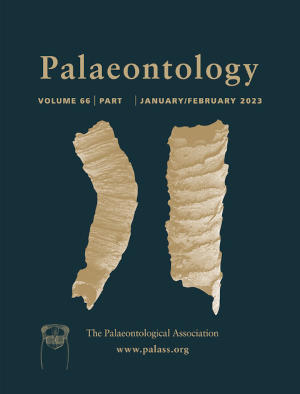Article: The dentary of hadrosauroid dinosaurs: evolution through heterochrony
Publication: Palaeontology
Volume:
66
Part:
5
Publication Date:
2023
Article number:
e12674
Author(s):
D. Fredrik K. Söderblom, Alejandro Blanco, Albert Prieto-Márquez, and Nicolás E. Campione
Abstract
Abstract The near-global distribution of hadrosaurid dinosaurs during the Cretaceous has been attributed to mastication, a behaviour commonly recognized as a mammalian adaptation. Its occurrence in a non-mammalian lineage should be accompanied by the evolution of several morphological modifications associated with food acquisition and processing. This study investigated morphological variation in the dentary, a major element of the hadrosauroid lower jaw. Eighty-four hadrosauroid dentaries were subjected to geometric morphometric and statistical analyses to investigate their taxonomic, ontogenetic, and individual variation. Results suggest increased food acquisition and processing efficiency in saurolophids through a complex pattern of evolutionary and growth-related changes. The edentulous region grew longer relative to dentary length, allowing for food acquisition specialization anteriorly and processing posteriorly, and became ventrally directed, possibly associated with foraging low-growing vegetation, especially in younger individuals. The saurolophid coronoid process became anteriorly directed and relatively more elongate, with an expanded apex, increasing moment arm length, with muscles pulling the jaw more posteriorly, increasing mechanical advantage. During growth, all hadrosauroids underwent anteroposterior dental battery elongation by the addition of teeth, and edentulous region ventralization decreased. The dental battery became deeper in saurolophids by increasing the number of teeth per tooth family. The increased coronoid process anterior inclination and relative edentulous region elongation in saurolophids are hypothesized to have evolved through hypermorphosis and/or acceleration, peramorphic heterochronic processes; the development of an anteroposteriorly shorter but dorsoventrally taller saurolophid dentary, is probably due to post-displacement in dental battery elongation and edentulous region decreased ventral orientation, a paedomorphic heterochronic process.
